Pressure sensitive labels are a versatile and dependable solution for identification, tracking, and compliance. Available in custom constructions for both print-on-demand and pre-printed applications, they adhere securely to a wide range of surfaces. Used across healthcare, laboratories, manufacturing, and more, these labels are engineered for performance and longevity.
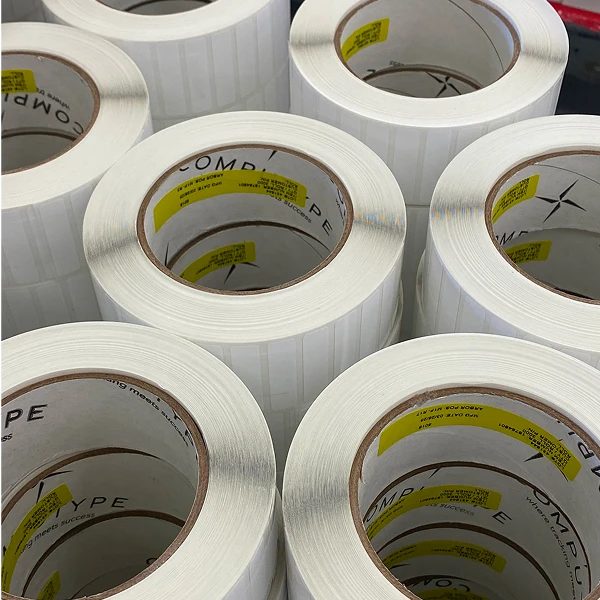
Face stocks are the visible foundation of every pressure sensitive label, carrying both printed information and protective coatings. Their performance impacts print quality, environmental durability, flexibility, and long-term readability. Selecting the right face stock is critical for ensuring the label stays legible, intact, and fit for its intended application.
Uncoated paper face stocks are the industry standard for low-cost, high-volume labels. They accept most printing methods but lack resistance to moisture, chemicals, or abrasion. Best suited for shipping labels, retail tags, and short-life applications. When paired with strong adhesives, paper can still perform reliably under light handling.
Polypropylene labels balance flexibility with chemical and moisture resistance. They resist tearing, making them suitable for healthcare, laboratory, and industrial uses where durability is needed without the rigidity of polyester. They are widely compatible with thermal transfer and digital printing. Variants include clear PP for no-label look and white PP for high contrast.
Polyester labels excel in demanding industrial settings. Their dimensional stability prevents shrinkage or stretching, even in high heat. PET films withstand abrasion, oils, solvents, and UV exposure, making them ideal for asset tracking, electronics, and outdoor use. Often paired with resin ribbons, they deliver long-lasting barcodes and identification in harsh conditions.
Polyimide films are engineered for survival in reflow soldering and wave soldering processes. With heat resistance exceeding 300°C, they retain print and adhesive integrity where other face stocks fail. Common in circuit board manufacturing, polyimide labels are compatible with high-resolution printing and withstand harsh solvents, providing durable identification under extreme stress.
Polyethylene labels offer high flexibility and low stiffness, allowing them to move with squeezable bottles, tubes, and flexible packaging. PE’s low surface energy can pose adhesion challenges, requiring adhesives with enhanced tackifiers. They are lightweight, moisture-resistant, and suitable for health, beauty, and consumer goods labeling where flexibility and resilience are needed.
Vinyl labels combine flexibility with weatherability, adhering to curved, rough, or irregular surfaces. They offer strong UV resistance, making them excellent for outdoor signs, safety labels, and equipment marking. Vinyl’s plasticizer content enhances flexibility but requires adhesive systems designed to resist migration. Available in both rigid and conformable grades for varied applications.
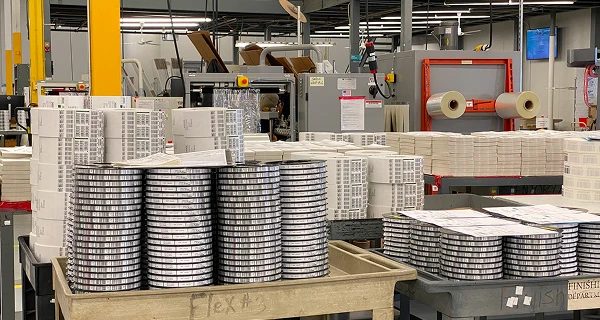
A stable face stock resists shrinkage, expansion, or warping under heat, cold, or moisture, preventing barcode distortion and maintaining scannability over time.
Highly conformable face stocks bond securely to curved, irregular, or flexible surfaces, ensuring adhesion without wrinkles, lifting, or reduced legibility.
Premium white stocks resist yellowing and discoloration, preserving contrast for barcodes and text, even under UV exposure or chemical contact.
Share your label challenges and performance expectations. We’ll match you with solutions tested to endure your processes, ensuring durability, readability, and compliance from day one.
Adhesives are the backbone of pressure-sensitive labels. While the face stock may provide the surface and the liner enables application, it is the adhesive that determines whether a label bonds instantly, survives extreme environments, or can be removed cleanly when needed. The complexity of adhesive chemistry—and the need to balance it with surfaces and environments—makes adhesive selection one of the most critical choices in label design.
Acrylics are the industry standard for pressure-sensitive labels. They bond well to most surfaces, resist yellowing from UV exposure, and maintain strength across a wide temperature range. Available in emulsion or solvent-based chemistries, acrylic adhesives are ideal for durable labeling in labs, industrial environments, and outdoor applications where longevity matters.
Rubber-based adhesives are formulated for maximum tack and fast bonding, especially on low-energy or rough surfaces. They excel in quick-stick applications like tire tread, warehouse labels, and curved plastics. However, they lack UV, chemical, and high-temperature resistance, making them best for short- to medium-term indoor applications.
Engineered adhesives address applications where standard chemistries fail. Cryogenic adhesives remain tacky at -196°C for biobank storage. High-temperature adhesives endure soldering processes and automotive heat. Removable adhesives allow clean peel-off without residue. Each specialty system is tuned to specific challenges, ensuring labels survive or release exactly as required.

Strong peel adhesion keeps labels fixed under stress, guaranteeing they won’t detach during shipping, handling, or extended product use.
High initial tack helps labels grip immediately, even on difficult surfaces, ensuring fast application without repositioning or failure.
Good shear strength prevents labels from slipping, sagging, or drifting when exposed to pressure, gravity, or environmental stress.
Solvent-based adhesives use organic solvents to dissolve acrylic or rubber polymers, creating highly durable bonds. Once applied, the solvent evaporates, leaving a dense adhesive film with excellent chemical, UV, and high-temperature resistance. These adhesives are ideal for automotive, electronics, and outdoor labels, though they require stricter handling and environmental controls.
Emulsion adhesives disperse polymers in water, creating a safer, more environmentally friendly system. They are widely used across healthcare, logistics, and consumer labeling due to their balance of adhesion, cost, and compliance. While less chemical- and heat-resistant than solvents, emulsion adhesives are the workhorse choice for general-purpose pressure-sensitive labels.
Hot melt adhesives are solid formulations melted during coating, then cooled to form a bond. They deliver strong initial tack and wet-out, even on low-energy or rough surfaces, making them ideal for warehouse, tire, and industrial labels. However, they have limited resistance to high heat, solvents, and outdoor exposure.
These resins enhance wet-out and surface contact, ensuring labels grip instantly to challenging materials like plastics, glass, or coated metals.
By softening adhesive films, plasticizers improve conformability on curved or textured surfaces, helping labels maintain secure bonds without lifting or edge failures.
Chemical crosslinks increase cohesive strength, chemical resistance, and heat tolerance, making adhesives reliable in extreme environments or long-term industrial applications.
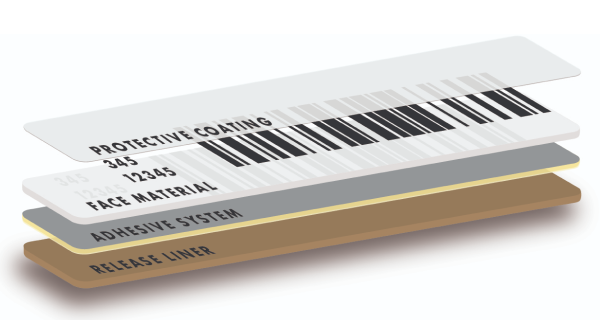
Ensuring that labels perform as expected requires rigorous testing across real-world and accelerated conditions. At Computype, we’ve built a laboratory dedicated to simulating harsh environments, validating durability, and benchmarking performance. From chemical soaks to cryogenic chambers, every test is designed to confirm that labels maintain adhesion, legibility, and compliance over the full product lifecycle

All validation is conducted under ISO 9001-certified processes, ensuring traceability, repeatability, and industry-recognized quality management.
We validate performance across extreme temperatures, from liquid nitrogen cryo storage to high-heat curing, covering the widest range of environments.
ANSI/ISO barcode grading confirms compliance and readability, reducing scanning errors and protecting productivity in high-throughput workflows.
Labels are exposed to solvents, cleaners, and reagents—including xylene, ethanol, isopropanol, and acids—to confirm adhesion and print integrity under harsh use.
Temperature and humidity cycling simulate years of exposure, providing reliable forecasts of label durability without requiring real-time aging.
Labels exposed to elevated temperatures—like curing ovens, solder reflow, or autoclaves—require heat-stable materials, adhesives, and inks that won’t discolor, shrink, or lift.
Cryo labels must remain adhered and legible at -80°C or lower, including during immersion in liquid nitrogen. Specialized adhesives and face stocks prevent brittleness or adhesive failure.
Solvents, alcohols, acids, and reagents can compromise both the printed image and label structure. Chemically resistant constructions protect both, even under frequent exposure.
Repeated handling, friction from equipment, and storage in tight containers can wear down labels. Durable topcoats, laminates, or ribbon/image combinations help preserve readability.
Labels used in lab or clinical workflows often undergo sterilization processes like autoclaving, gamma radiation, or chemical exposure. The entire construction must survive without delaminating.
Labels may encounter condensation, spills, or immersion during use or cleaning. Moisture-resistant labels prevent edge lift, adhesive failure, and print smearing under wet conditions.
Chemical exposure is one of the leading causes of label failure in laboratories, hospitals, and industrial environments. To verify chemical resistance, labels are exposed to a wide spectrum of solvents, reagents, and cleaning solutions. Testing involves submersion, repeated wiping, or spray exposure with substances such as alcohols, xylene, DMSO, acids, bases, oils, and disinfectants. After treatment, the labels are examined for print degradation, discoloration, adhesive lift, or edge penetration. Evaluation covers both the face stock and printed image, since even if the adhesive holds, a blurred or dissolved barcode can compromise traceability. Labels that pass chemical resistance testing provide assurance that critical data will remain intact despite contact with aggressive agents. This is especially vital in regulated settings where legibility and scan reliability must be maintained through repeated cleaning, sterilization, or chemical handling.
Temperature extremes challenge both adhesives and face stocks in unique ways. To validate performance, labels are subjected to controlled cycles of high heat and deep cold. Cryogenic testing can involve storage in liquid nitrogen vapor phase or mechanical freezers down to –196°C, while heat testing may reach several hundred degrees Celsius for materials applied to glassware, metal, or ceramic surfaces. Labels are monitored for cracking, embrittlement, delamination, or adhesive failure as temperatures fluctuate. Freeze-thaw cycling is often included to simulate real-world handling, where containers move in and out of cold storage. High-heat validation may also include dry ovens or heated block surfaces to ensure that print remains legible and adhesives maintain cohesion. Passing this test ensures that labels can be relied upon in extreme environments such as cryo-banking, autoclaves, industrial furnaces, and automotive under-hood components.
An adhesive must provide consistent, long-term bonding across many substrates and environments. To validate this, we use a range of standardized tests. Peel adhesion tests measure the force required to remove a label from a surface at a set angle (usually 90° or 180°) and speed, providing insight into initial tack and ultimate bond strength. Shear testing evaluates cohesive strength by applying a constant load parallel to the bond line to determine how well the adhesive resists slippage under stress. Tack testing quantifies the adhesive’s ability to make immediate contact and form a bond, which is critical for low-temperature or high-speed applications. Labels are also exposed to environmental cycling — changes in temperature, humidity, or UV exposure — to observe any edge lifting, adhesive migration, or residue upon removal. These evaluations are conducted on multiple surfaces, from high-energy glass and metals to difficult low-surface-energy plastics. By combining laboratory measurements with simulated real-world conditions, adhesive performance testing ensures labels deliver secure adhesion for the life of the product without compromising removability or clean release when required.
Long-term durability is difficult to evaluate in real time, so accelerated aging techniques are used to predict a label’s performance over months or years. Labels are exposed to controlled cycles of heat, humidity, and UV light to simulate extended storage or usage conditions. The process allows engineers to assess potential changes in adhesive tack, face stock flexibility, or image clarity before failures occur in the field. Labels are then inspected for yellowing, cracking, edge lift, or fading of printed information. Data from these tests are cross-referenced with real-world conditions to ensure accuracy in predictions. This is especially critical for industries with long product lifecycles, such as automotive, aerospace, and medical devices, where traceability must be maintained for years. Passing accelerated aging validation provides confidence that labels will not degrade prematurely and ensures compliance with warranties, regulatory retention requirements, and archival integrity.
Labels in circulation are often exposed to abrasion from handling, storage, or mechanical processing. Abrasion resistance testing subjects labels to rubbing, scraping, or contact under controlled pressure and frequency to replicate real-world wear. Both face stock and printed image are evaluated for resilience against smudging, scratching, or surface erosion. Barcode labels are tested for continued scan reliability after cycles of abrasion, while human-readable information is checked for legibility. In some cases, testing includes additional stress factors such as exposure to dirt, dust, or cleaning cloths. Abrasion resistance is especially important in industrial environments, logistics centers, and laboratories where containers are handled repeatedly. A label that passes ensures not only physical durability but also confidence that the data it carries will survive heavy use without the need for relabeling.
For barcoded labels, readability is as important as physical survival. Barcode verification evaluates the quality and accuracy of printed symbologies under ISO/ANSI grading standards. Labels are scanned using calibrated verification equipment that measures parameters such as contrast, edge definition, modulation, and quiet zones. Testing also considers how labels perform after exposure to environmental stress, abrasion, or chemical contact, ensuring that barcodes remain scannable throughout their lifecycle. A failing grade can mean misreads, slower throughput, or regulatory noncompliance. This test provides assurance that labels integrate seamlessly into automated data capture systems and comply with requirements for industries like healthcare, aerospace, and retail. Reliable barcode verification reduces risk, prevents costly errors, and ensures smooth operation across the supply chain.
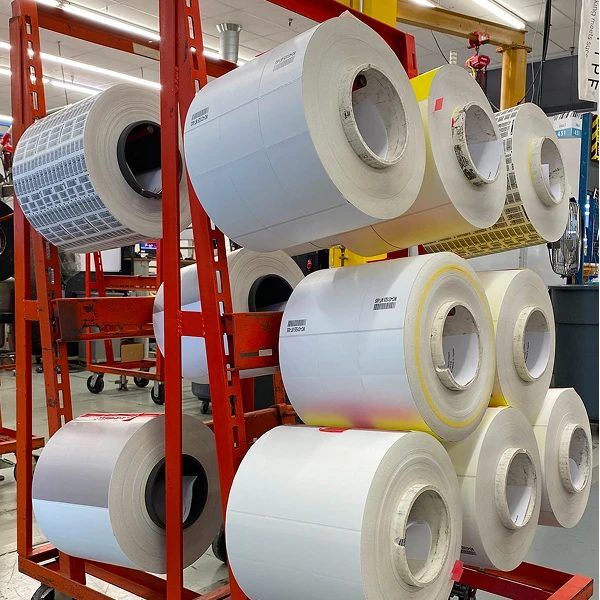
We don’t assume compatibility or endurance — we test it. Our lab simulates real-world stress like temperature swings, abrasion, adhesion, and chemical exposure to ensure labels perform not just in theory, but in practice.
Labels aren’t just built — they’re completed through printing, converting, and finishing steps that define how they’ll look, perform, and integrate into your workflow. These processes determine whether a label carries only the essential data, a full-color design, or a mix of both. Choosing the right option balances durability, flexibility, and customization, ensuring each label is fit for purpose.
Blank labels offer maximum flexibility. They allow you to add information only when it’s available, whether that’s at the point of use or just before application. Commonly paired with thermal transfer or direct thermal printers, blank labels are also practical for handwriting in low-volume, quick-turn environments.
Partially pre-printed labels strike a balance between durability and flexibility. They can feature your logo, color bands, or permanent text, while leaving space for variable data such as barcodes or dates. This hybrid option allows you to maintain brand consistency and durability while still responding to real-time data needs.
Fully pre-printed labels arrive ready for immediate use, with permanent inks and protective coatings applied during production. This option is ideal for applications requiring extreme durability, where data is known in advance, or where branding and full-color designs are critical. Often paired with topcoats to enhance abrasion and chemical resistance.

Selecting the right label shape and size is essential for proper adhesion and long-lasting performance. Labels must contour to curved or irregular surfaces, matching the product’s shape for the best results. Although it might seem like a rectangular label would work for any product, specialized shapes are often needed for the best fit and performance.
Bullet labels are custom die-cut for conical objects like microcentrifuge tubes. Their narrow shape allows for printing a linear barcode and text down the length of the tube, solving the challenges of labeling due to the tapered design
Flag labels wrap around cylindrical objects like tubes, hoses, or cables, with the ends adhering to each other. This creates a “flag” that extends outward, offering extra space for information for easy scanning and identification.
Laminate labels protect printed information with a clear cover. Wrap-around labels shield cylindrical surfaces, FLAP labels fold over a square print space, and paint patch labels feature a removable laminate that protects during painting.
Rotary or flatbed die-cutting ensures exact label dimensions, clean edges, and reliable release, essential for both automated and manual application.
Clear films applied over the face stock add resilience against solvents, scratches, and UV light while preserving legibility of text and barcodes.
Easy-tear perforations, fold lines, or scored liners help streamline hand application and reduce errors during high-volume dispensing.
Labels stacked in a zig-zag fold instead of wound on rolls reduce downtime, ease high-volume feeding, and eliminate curl in thermal printers.
Pre-grouped labels — such as tube/cap sets or matching asset tags — ensure accuracy, save time, and support traceability across multiple items.
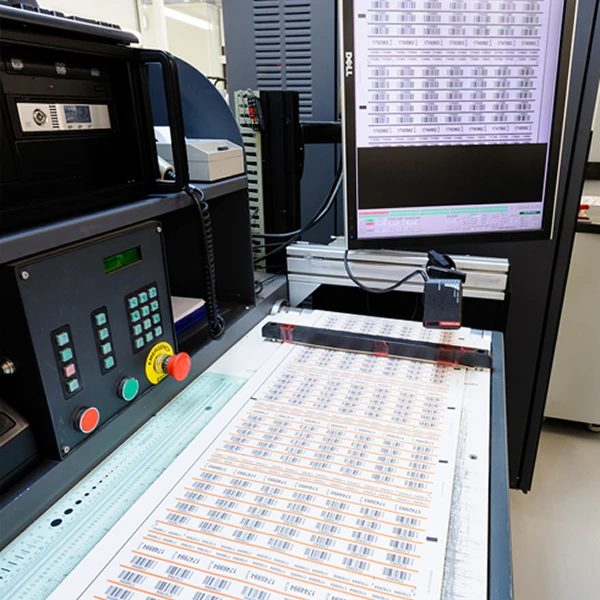
Pressure sensitive labels are used across industries to meet identification, compliance, and durability requirements. From laboratories to logistics, each use case demands specialized face stocks, adhesives, coatings, and printing strategies. Understanding the most common applications helps illustrate the versatility and critical importance of engineered label constructions.
Laboratory labeling solutions are designed for cryogenic storage to –196 °C, solvent exposure, and autoclaving. Specialized adhesives and laminates ensure secure bonding to tubes, vials, and slides. Self-laminating wraps add durability, while chemical-resistant coatings maintain barcode clarity. Reliable labeling ensures sample integrity across biobanking, diagnostics, and clinical research.
Healthcare applications require labels that maintain adhesion through refrigeration, sterilization, and handling. Adhesives bond to flexible bags, tubing, or glass without leaching. Barcodes must remain scannable, supporting ISBT 128 compliance and patient safety. High-quality printing prevents errors and ensures accurate tracking from collection to transfusion or diagnostic testing.
Libraries and archives depend on labels engineered for permanence without damaging valuable materials. Adhesives avoid staining or migration, while fade-resistant ribbons and protective coatings keep barcodes readable after decades of handling. Labels support efficient cataloging and circulation while preserving the integrity of priceless collections in both public and historical repositories.
Automotive and industrial processes demand labels that withstand harsh environments including oils, fuels, abrasion, and curing cycles reaching 350 °C. Polyimide face stocks and solvent-resistant adhesives prevent failure. Applications include tire tread and bead labels, under-hood components, and industrial machinery, ensuring compliance, safety, and reliable traceability throughout product lifecycles.
Electronics labels are engineered for extreme conditions, including solder reflow up to 350 °C and solvent cleaning. Polyimide face stocks paired with durable adhesives prevent delamination. Cable labels require flexibility, abrasion resistance, and clear printing for tight geometries. These solutions ensure compliance, traceability, and reliability throughout electronics manufacturing, service, and end use.
Logistics labels must remain scannable in fast-paced supply chains. Adhesives balance permanence for pallets with removability for reusability. Options include fanfold formats for bulk handling, durable laminates for outdoor shipping, and RFID-enabled inlays for smart tracking. Reliable barcode readability ensures efficiency, reducing errors and delays across complex warehouse and distribution networks.
Some labels do more than identify—they protect, signal, or comply. These specialty applications often require custom layering, engineered adhesives, or enhanced visual zones. Whether meeting regulatory standards or adding physical functionality, these labels are built to do more.
Tamper resistance or evidence of interference
Recyclable or compostable material options
Multi-color layouts for hazard or safety labeling
Durable imaging for regulatory documentation
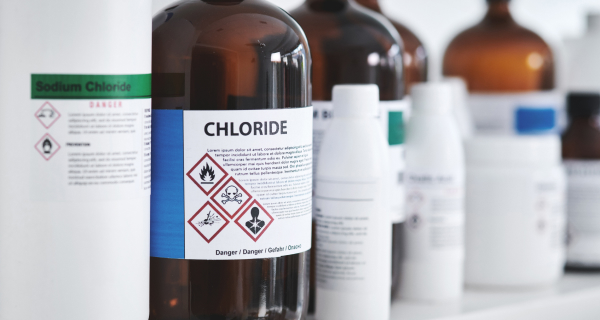
These labels provide a visual or physical indicator when packaging or equipment has been opened or altered. Common in pharmaceutical, clinical, and safety-critical workflows, tamper evident constructions help support compliance and trust. Solutions include destructible films, void patterns, and labels that break or delaminate on removal.
Sustainable options focus on recyclability, compostability, or reduced material usage. These constructions use materials like recyclable liners, thinner face stocks, and solvent-free adhesives. Labels can also be designed to meet sustainability certifications or support closed-loop product programs.
Designed to meet strict standards for hazard communication, product classification, and workplace safety. These labels support formats like GHS, HMIS, and CLP with regulated colors, icons, and layout. Often used in labs, chemical manufacturing, and industrial environments where labeling is tied to compliance.

Have questions? We’re here to help.
Contact us to connect with a specialist who understands your industry and can provide the right solutions for your business. Let’s start a conversation.
Take advantage of our volume discounts for bulk orders. Reach out to us for a personalized quote tailored to your needs.
"*" indicates required fields